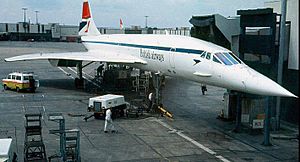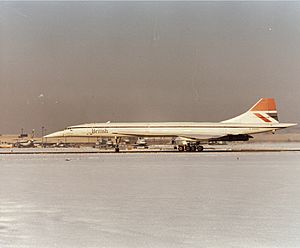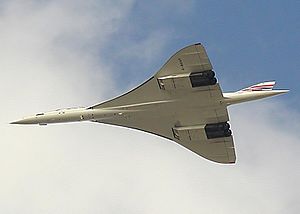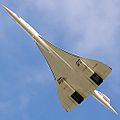Concorde facts for kids
Quick facts for kids Concorde |
|
|---|---|
 |
|
| A British Airways Concorde at Heathrow airport in London | |
| Role | Supersonic airliner |
| Manufacturer | BAC (now BAE Systems) Sud-Aviation, Aérospatiale (now EADS) |
| First flight | 2 March 1969 |
| Introduction | 21 January 1976 |
| Retired | 26 November 2003 |
| Status | Retired from service |
| Primary users | British Airways Air France |
| Number built | 20 (including 6 non-airline aircraft) |
| Program cost | £1.3 billion |
| Unit cost | £23 million in 1977 |
The Aerospatiale-BAC Concorde was a very special passenger plane. It was the only supersonic (meaning faster than sound) airliner that ever flew for regular passengers.
Concorde could fly incredibly fast, reaching speeds of over twice the speed of sound (called Mach 2.04). It also flew very high, at 60,000 feet (about 18,000 meters). This plane had a unique delta wing shape and powerful engines.
Only 20 Concorde planes were ever built. Most of them were used by airlines. The last flight for an Air France Concorde was on May 31, 2003. The final flight for a British Airways Concorde was on October 24, 2003. This last flight went from John F. Kennedy airport in New York to London Heathrow.
Contents
How Concorde Started
In the late 1950s, several countries were interested in building planes that could fly faster than sound. These included the British, French, Americans, and Russians.
Two companies, Britain's Bristol Aeroplane Company and France's Sud Aviation, were working on their own designs. Their governments helped pay for these projects. They wanted to compete with the United States, which built most of the world's airplanes at the time.
Building these planes was very expensive. So, the British and French companies decided to work together. They signed an agreement on November 28, 1962. The Concorde project became a joint effort between British Aircraft Corporation and Aerospatiale.
At first, many airlines wanted to buy Concorde planes. They placed orders for over 100 aircraft. Pan Am, BOAC, and Air France were among the first customers. Each ordered six Concordes.
The very first Concorde, called 001, took off for its first test flight from Toulouse on March 2, 1969. Its first flight faster than sound happened on October 1 of the same year.
However, things got difficult for the project. There was an oil crisis in the 1970s, which made fuel very expensive. Airlines also faced money problems. Another supersonic plane, the Russian Tupolev Tu-144, had a big accident. People also worried about the loud noise (called a sonic boom) Concorde made. They were also concerned about its effect on the ozone layer.
Because of these problems, many airlines canceled their orders. In the end, only Air France and British Airways bought the planes. They even bought the unsold aircraft and parts for a very low price. The US also stopped its own supersonic plane project in 1971.
Both European airlines started flying demonstration and test flights in 1974. They flew to different places to show off the plane.
Regular Flights Begin
Regular passenger flights began on January 21, 1976. The first routes were from London to Bahrain and from Paris to Rio. At this time, the United States Congress had banned Concorde from landing in the US. This stopped it from flying on the popular routes across the Atlantic.
The US ban was lifted in February. But then, New York city banned Concorde landings locally. So, Air France and British Airways started transatlantic flights to Washington D.C. on May 24.
Finally, in late 1977, New York residents agreed to allow Concorde flights. They realized the benefits of the plane. So, regular flights from Paris and London to New York's John F. Kennedy airport began on November 22, 1977.
The average flight time on these routes was just under 3.5 hours. Until 2003, both airlines flew to New York daily. Concorde also flew to Barbados during winter holidays. Sometimes, it flew to other places like Rovaniemi, Finland, for special charter trips. On November 1, 1986, a Concorde even flew around the world in just under 32 hours!
Concorde's Safety Record
Concorde was known for being a very safe airliner. Sadly, this changed when a plane crashed during takeoff in Paris on July 25, 2000. All 113 people on board died.
After the accident, all Concorde flights were stopped. This allowed for a full investigation. After safety improvements were made, flights started again on November 7, 2001.
The investigation found out what caused the crash. A small piece of titanium metal had fallen onto the runway from another plane. As the Concorde took off, it ran over this metal strip. This punctured one of its tires. Pieces of the shredded tire then hit the plane's wing. This broke a fuel tank, causing a huge fire. The plane lost control and crashed into a hotel near the airport.
Why Concorde Stopped Flying
On April 10, 2003, British Airways and Air France announced they would stop flying Concorde later that year. They said that not enough passengers were flying after the 2000 crash. Also, the cost to maintain the planes was getting too high.
That same day, Sir Richard Branson offered to buy British Airways' Concordes for just £1 each. He wanted to use them for his Virgin Atlantic Airways. But British Airways refused his offer.
Air France's last Concorde landing in the United States was in New York City on May 30, 2003. Trucks sprayed arcs of water over the plane as a special farewell. The plane made its final commercial flight back to Paris the next day. British Airways stopped flying its Concordes on October 24 of that year.
After retiring its five Concordes, Air France gave one to the Sinsheim Auto & Technik Museum in Germany. It joined a Russian Tupolev TU-144 already on display there.
The other four Air France Concordes went to:
- The Smithsonian National Air and Space Museum in Washington, DC
- Charles de Gaulle International Airport in Paris
- The French Air and Space Museum, Paris
- An aeronautics park in Toulouse
Images for kids
-
British Airways Concorde in early BA livery at London-Heathrow Airport, in the early 1980s
-
British Airways Concorde in Singapore Airlines livery at Heathrow Airport in 1979
-
Air France Concorde at CDG Airport in 2003
-
A Concorde at the Intrepid Museum in New York City
-
BA Concorde G-BOAB at London Heathrow Airport. This aircraft flew for 22,296 hours between its first flight in 1976 and its final flight in 2000, and has remained there ever since.
-
Parade flight at the Queen's Golden Jubilee, June 2002
See also
 In Spanish: Concorde para niños
In Spanish: Concorde para niños


























